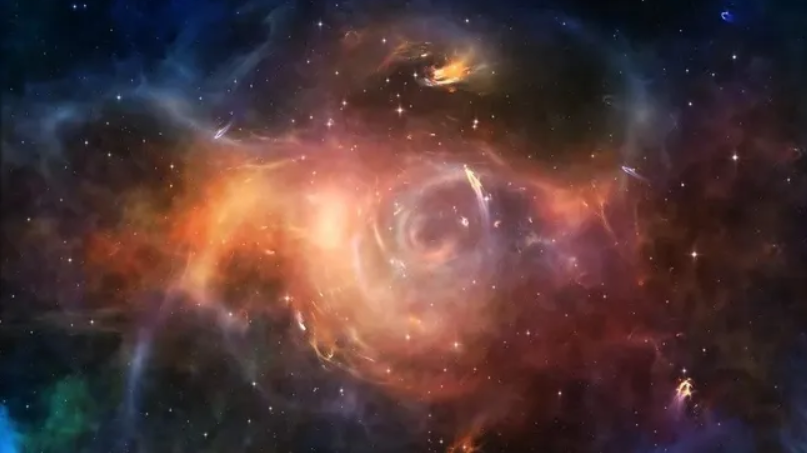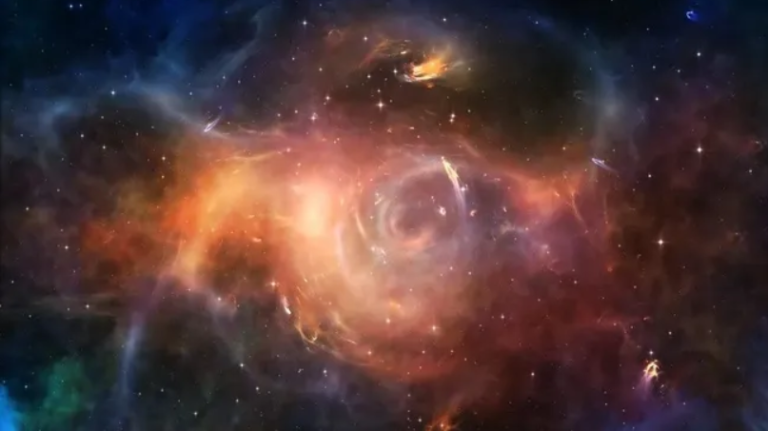Astronomers Suggest Utilizing Newly Discovered Ancient Radio-Wave Outburst for Universe Weight Measurement
Astronomers have identified a puzzling radio signal originating from the convergence of three galaxies located 8 billion light-years distant. Investigating this phenomenon might offer insights into the elusive matter that the universe contains.

Astronomers have unearthed the most ancient “pulsating” radio signal, and they intend to leverage it to unravel the enigma of the universe’s missing matter.
This enigmatic signal, labeled as FRB 20220610A, is a fast radio burst detected 8 billion years into the universe’s past, emanating from the heart of three merging galaxies. Given that this fast radio burst (FRB) predates the prior record-holder by 1.5 times in both age and distance, its radiance may offer an approximate measure of the universe’s mass. This, in turn, could facilitate the quest to locate the elusive half of the universe’s matter. The findings were reported on October 19 in the journal Nature.
As study co-lead author Ryan Shannon, a professor of astrophysics at Swinburne University in Australia, pointed out, “If we tally up the quantity of ordinary matter in the Universe—the atoms composing all of us—we discover that over half of what should be present today remains unaccounted for.” He explained that this missing matter is assumed to be dispersed in the regions between galaxies, yet its extreme rarity and diffuse nature make it nearly impossible to detect using conventional techniques.
Currently, there are two methods to estimate the universe’s matter content. The first relies on gravitational lensing to observe how matter bends the path of light from distant galaxies as it traverses space, while the second analyzes the cosmic microwave background, the lingering radiation from the Big Bang, which reveals how matter aggregated during the universe’s inception and evolved over time.
However, a significant challenge arises from the discrepancy between these approaches, known as the Sigma-8 tension, which threatens to undermine established cosmological theories. The location of the missing matter remains uncertain, but astronomers suspect it exists in intergalactic space, concealed within extensive, diffuse clouds of gas and dust. To measure these clouds, astronomers require potent sources of illumination.
Fast radio bursts are ideally suited for this purpose, emitting more energy in a fraction of a second than the sun does in a year. While the origins of these abrupt, brilliant flashes have long puzzled scientists, their ephemeral nature and remote locations, often spanning millions or billions of light-years, have made them challenging to pinpoint.
One recognized source of FRBs is a radio pulsar or magnetar, the remnants of a highly magnetized, swiftly rotating deceased star. Possessing magnetic fields trillions of times more powerful than Earth’s, these stars rotate in space, projecting intense radio waves like colossal lighthouses from their poles.
As FRB signals traverse space, the matter they traverse disperses the signal’s various frequencies, creating a delay between the arrival of high and low frequencies in the signal. This delay’s duration allows astronomers to determine the amount of matter the burst has traversed.
Up to this point, astronomers had only detected bursts dating back slightly over 5 billion years into the universe’s past, rendering this calculation unfeasible. However, the recently identified fast radio burst, harking back to 8 billion years ago within the universe’s 13-billion-year existence, brings new hope.
In the words of Shannon, “While the exact cause of these colossal energy bursts remains unknown, the study affirms that fast radio bursts are frequent occurrences in the cosmos, and they can be harnessed to detect matter between galaxies, thereby enhancing our comprehension of the universe’s structure.”
This article is republished from LiveScience under a Creative Commons license. Read the original article.
Do not forget to share your opinion with us to provide you with the best posts !




0 Comments